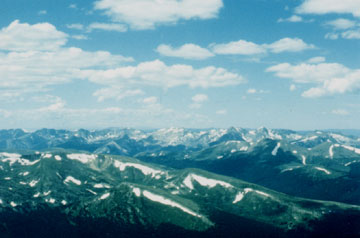Boundary Layer Convection
|
|
w* = (g Ho Zi
/ T)1/3
|
Boundary Layer Convection is the result of surface fluxes of heat and moisture triggering small-scale non-precipitating updrafts. Cloud-top radiative cooling can also play an important role. Scales range from a few 10s of m to a few km in the horizontal and a few hundred m to a few km in the vertical. The up- and downdrafts of boundary layer convection is the primary way in which the atmosphere moves heat, moisture, momentum, and pollutants between the Earth's surface and the atmosphere. Thus, boundary layer convection is important in the global climate modeling, numerical weather prediction, air-quality modeling, and the dynamics of numerous mesoscale phenomena. The role of boundary layer convection in triggering thunderstorms remains largely unexplored as does the extent to which small scale terrain features impact the location and structure of boundary layer convective elements.
Field Experiments | Selected Publications
|
Year |
Project |
Location |
Platform |
|
2013-2014 |
Lake
Ontario |
University
of Wyoming KingAir Aircraft |
|
|
1997-1998 |
Lake
ICE |
Lake
Michigan |
NCAR
Electra Aircraft |
|
1992 |
ASTEX |
Eastern
North Atlantic |
NCAR Electra Aircraft |
|
Research
Vessel Oceanus |
|||
|
1987 |
FIRE |
Eastern
North Pacific |
NCAR
Electra Aircraft |
|
1984 |
PHOENIX
84 |
Colorado |
NCAR
Kingair Aircraft |
- Kristovich, D.A.R., R. Clark, J. Frame, B. Geerts, K. Knupp, K. Kosiba, N. Laird,
J. Minder, N. Metz, T. Sikora, J. Steenburgh, S. Steiger, J. Wurman, G. Young, 2016: The Ontario Winter Lake-effect
Systems (OWLeS) project. Bulletin of
the American Meteorological Society. in press. -- Abstract
- Young, G.S., D.A.R. Kristovich, M.R. Hjelmfelt, R.C.
Foster, 2002: Rolls, streets, waves, and more: A review of quasi-two
dimensional structures in the atmospheric boundary layer. Bulletin of
the American Meteorological Society, 83, 997-1001. Also,
an extended electronic supplement --- Abstract
- Mason, R.A., H.N. Shirer, R. Wells, G.S. Young, 2002:
Improved description of fluxes by convective plumes within the marine
atmospheric surface layer. Journal of the Atmospheric Sciences, 59,
1337-1355. --- Abstract
- Young G.S., T.D. Sikora, and N.S. Winstead, 2000: On
inferring marine atmospheric boundary layer properties from the spectral
characteristics of satellite-borne SAR imagery. Monthly Weather Review,
128, 1506-1520. --- Abstract
- Young, G.S., B.K. Cameron, E.E. Hebble,
2000: Observations of the entrainment zone in a rapidly entraining
boundary layer. Journal of the Atmospheric Sciences, 57,
3145-3160. --- Abstract
- Kristovich, D.A.R., G.S. Young, J. Verlinde, P.J, Sousounis, P. Mourad, D. Lenschow, R.M. Rauber, M.K.
Ramamurthy, B.F. Jewett, K. Beard, E. Cutrim,
P.J. DeMott, E.W. Eloranta,
M.R. Hjelmfelt, S.M. Kreidenweis, J. Martin, J.
Moore, H.T. Ochs III, D.C. Rogers, J. Scala, G. Tripoli, J. Young, 2000:
The lake-Induced Convection Experiment and the
Snowband Dynamics Project. Bulletin of the American Meteorological
Society, 81, 519-542. --- Abstract
- Young, G.S., 1999: Some SAR signatures of the marine
atmospheric boundary layer: Implications for numerical forecasting. Johns
Hopkins University Applied Physics Laboratory Technical Digest, 21,
27-32. --- Abstract
- Sikora, T.D., G.S. Young, H.N. Shirer, and R.D.
Chapman, 1997: Estimating convective atmospheric boundary layer depth from
microwave radar imagery of the sea surface.Journal
of Applied Meteorology, 36, 833-845. --- Abstract
- Rinker, D.K., and G.S. Young, 1996: Use of obliquely
rotated principal component analysis to identify coherent structures. Boundary-Layer
Meteorology, 80, 19-47. --- Abstract
- Sikora, T.D., G.S. Young, R.C. Beal, and J.B. Edson,
1995: Use of spaceborne synthetic aperture radar imagery of the sea
surface in detecting the presence and structure of the convective marine
atmospheric boundary layer. Monthly Weather Review, 123,
3623-3632. --- Abstract
- Moyer, K.A., and G.S. Young, 1994: Observations of
mesoscale cellular convection from the marine stratocumulus phase of FIRE.
Boundary-Layer Meteorology., 71, 109-133. --- Abstract
- Sikora, T.D., and G.S. Young, 1994: Observations and
applications of the horizontal perturbation wind field within convective
structures of the marine atmosphere surface layer. Boundary-Layer
Meteorology, 68, 419-426. --- Abstract
- Sikora, T.D., and G.S. Young, 1993: Observations of planview flux patterns within convective structures of
the marine atmospheric surface layer. Boundary-Layer Meteorology, 65,
273-288. --- Abstract
- Moyer, K.A., and G.S. Young, 1993: Buoyant forcing
within the marine stratocumulus-topped boundary layer. Journal of the
Atmospheric Sciences, 50, 2759-2771. --- Abstract
- Nucciarone, J.J., and G.S. Young,
1991: Aircraft measurements of turbulence spectra in the marine
stratocumulus topped boundary layer. Journal of the Atmospheric
Sciences, 48, 2382-2392. --- Abstract
- Moyer, K.A., and G.S. Young, 1991: Observations of
vertical velocity skewness within the marine stratocumulus-topped boundary
layer. Journal of the Atmospheric Sciences, 48, 403-410. ---
Abstract
- Young, G.S., 1988: Convection in the atmospheric
boundary layer. Earth Science Reviews., 25, 179-198. --- Abstract
- Young, G.S., 1988: Turbulence structure of the
convective boundary layer III: The vertical velocity budgets of thermals
and their environment. Journal of the Atmospheric Sciences, 45,
2039-2049. --- Abstract
- Young, G.S., 1988: Turbulence structure of the
convective boundary layer II: PHOENIX 78 aircraft observations of thermals
and their environment. Journal of the Atmospheric Sciences, 45,
727-735. --- Abstract
- Young, G.S., 1988: Turbulence structure of the
convective boundary layer I: Variability of normalized turbulence
statistics. Journal of the Atmospheric Sciences, 45,
719-726. --- Abstract
- Young, G.S., 1987: Mixed layer spectra from aircraft
measurements. Journal of the Atmospheric Sciences, 44,
1251-1256. --- Abstract
